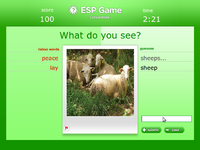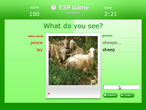ESP game
Cs Portal > List of citizen science projects > ESP game - (2013/11/05)
IDENTIFICATION
- Beta start date : N/A
- End date : The project was closed on 2011/09/01
- Engineering and technology > (other)
- Others in the same subject areas: ARL crowd sourcing, CS4CS, GeoTag-X, ReCaptcha... further results
- Others projects about other: ARL crowd sourcing, CS4CS, ReCaptcha, Transcribe Bentham
⇳ Description [[Has project description::According to Wikipedia (10/2013), The ESP Game is an idea in computer science for addressing the problem of creating difficult metadata. The idea behind the game is to use the computational power of humans to perform a task that computers cannot do (originally, image recognition) by packaging the task as a game. It was originally conceived by Luis von Ahn of Carnegie Mellon University.
Google bought a licence to create its own version of the game in 2006 called "Image labeler" in order to return better search results for its online images. Google's version was shut down on September 16, 2011 as part of the Google Labs closure in September 2011.]] ➠ Purpose Tag a large collection of images with keywords in order to find out if participants can help create more accurate image searching and accessibility for visually impaired users. ? Research question There are two sets of questions:
- Some are related to the quality of results
- Others are related to good game design. Ahn and Dabash (2006) formulate a set of design rules for designing games with a purpose (GWAPs)
TEAM
Carnegie Mellon University
Project team page http://www.cs.cmu.edu/~biglou/ Leader: Luis von Ahn Institution: Carnegie Mellon University Partner institutions: Contact:
USER TASKS
CONTRIBUTION TYPE: data collection
PARTICIPATION TYPOLOGY: crowdsourcing
GAMING GENRE Puzzle
GAMING ELEMENTS: Achievements
◉ Tasks description
⤯ Interaction with objects The authors define ESP as GWAP (games with a purpose) and a subgenre "output-agreement games" Output-agreement games are a generalization of the ESP Game to its fundamental input-output behavior:
- Initial setup: Two strangers are randomly chosen by the game itself from among all potential players;
- Rules: In each round, both are given the same input and must produce outputs based on the input. Game instructions indicate that players should try to produce the same output as their partners. Players cannot see one another’s outputs or communicate with one another;
- Winning condition: Both players must produce the same output; they do not have to produce it at the same time but must produce it at some point while the input is displayed onscreen.
When the input is an image and the outputs are keyword descriptions of the image, this template becomes the ESP Game ▣ Interface
- Data type to manipulate: pictures
- interface enjoyment: somewhat cool/attractive
- Interface usability: easy to use
GUIDANCE
- Tutorial: Somewhat
- Peer to peer guidance: Somewhat
- Training sequence: Somewhat
- Individual performance: Somewhat
- Collective performance: Somewhat
- Research progress: Somewhat
❂ Feedback and guidance description
COMMUNITY
- Communication:
- Social Network: N/A
- Member profiles:: N/A
- Member profile elements:
- Main news site:
- Frequency of project news updates: N/A
- Type of events:
- Frequency of events :
⏣ Community description
- Community size (volounteers based) 200000
- Role:
- Interaction form:
- Has official community manager(s): N/A
- Has team work N/A
- Other:
- Community led additions: 2011/09/01
Other information
PROJECT
Url:http://www.espgame.org/
Start date: 2004/01/01
End date: 2011/09/01
TEAM
Official team page:http://www.cs.cmu.edu/~biglou/
Leader: Luis von Ahn
Institution: Carnegie Mellon University
Main location: Carnegie Mellon University
PROJECT DEFINITION
Subject
Engineering and technology > (other)
Description
According to Wikipedia (10/2013), The ESP Game is an idea in computer science for addressing the problem of creating difficult metadata. The idea behind the game is to use the computational power of humans to perform a task that computers cannot do (originally, image recognition) by packaging the task as a game. It was originally conceived by Luis von Ahn of Carnegie Mellon University. Google bought a licence to create its own version of the game in 2006 called "Image labeler" in order to return better search results for its online images. Google's version was shut down on September 16, 2011 as part of the Google Labs closure in September 2011.
Purpose.
Tag a large collection of images with keywords in order to find out if participants can help create more accurate image searching and accessibility for visually impaired users.
Research question.
There are two sets of questions:
- Some are related to the quality of results
- Others are related to good game design. Ahn and Dabash (2006) formulate a set of design rules for designing games with a purpose (GWAPs)
ABOUT PARTICIPANT TASKS
.
Interaction with system objects.
The authors define ESP as GWAP (games with a purpose) and a subgenre "output-agreement games" Output-agreement games are a generalization of the ESP Game to its fundamental input-output behavior:
- Initial setup: Two strangers are randomly chosen by the game itself from among all potential players;
- Rules: In each round, both are given the same input and must produce outputs based on the input. Game instructions indicate that players should try to produce the same output as their partners. Players cannot see one another’s outputs or communicate with one another;
- Winning condition: Both players must produce the same output; they do not have to produce it at the same time but must produce it at some point while the input is displayed onscreen.
| Grey typology | Participation typology | Contribution type: | ||||||||||||||||||||||||||||
|---|---|---|---|---|---|---|---|---|---|---|---|---|---|---|---|---|---|---|---|---|---|---|---|---|---|---|---|---|---|---|
|
|
|
||||||||||||||||||||||||||||
| Gaming | ||||||||||||||||||||||||||||||
| Genre: puzzle | Gaming elements: achievements | |||||||||||||||||||||||||||||
| Interface | ||||||||||||||||||||||||||||||
| Data type to manipulate: pictures | interface enjoyment: somewhat cool/attractive Interface usability: easy to use |
Member profiles::N/A Member profile elements: |
||||||||||||||||||||||||||||
ABOUT GUIDANCE AND FEEDBACK
| Guidance | Feedback on | ||||||||||||
|---|---|---|---|---|---|---|---|---|---|---|---|---|---|
|
|
.
COMMUNITY
| Tools | News & Events |
|---|---|
|
Communication: |
Main news site: |
| Community description | |
|
Community size (volounteers based): 200000 |
|
Other information about community:
Community led additions: 2011/09/01
OTHER PROJECT INFORMATION
esp-game.png No [[has completion level::Low]
http://www.cs.cmu.edu/~biglou/
Carnegie Mellon University
No
Engineering and technology other Tag a large collection of images with keywords in order to find out if participants can help create more accurate image searching and accessibility for visually impaired users. There are two sets of questions:
- Some are related to the quality of results
- Others are related to good game design. Ahn and Dabash (2006) formulate a set of design rules for designing games with a purpose (GWAPs)
ESP game
data collection
crowdsourcing pictures, other: Thinking: yes Computing: no Sensing: no Gaming: no achievements puzzle The authors define ESP as GWAP (games with a purpose) and a subgenre "output-agreement games" Output-agreement games are a generalization of the ESP Game to its fundamental input-output behavior:
- Initial setup: Two strangers are randomly chosen by the game itself from among all potential players;
- Rules: In each round, both are given the same input and must produce outputs based on the input. Game instructions indicate that players should try to produce the same output as their partners. Players cannot see one another’s outputs or communicate with one another;
- Winning condition: Both players must produce the same output; they do not have to produce it at the same time but must produce it at some point while the input is displayed onscreen.
When the input is an image and the outputs are keyword descriptions of the image, this template becomes the ESP Game somewhat cool/attractive easy to use N/A N/A N/A N/A N/A N/A
N/A
N/A
N/A
200000 N/A
N/A
Low
The followup game (Phetch) is more ambitious. According to Ahn et al. (2006): We set our goal to assign proper descriptions to arbitrary images. A “proper” description is correct if it makes sense with respect to the image, and sufficient if it gives enough information about its contents. Phetch will collect sentences
Bibliography
| BIBLIOGRAPHY |
Improving Accessibility of the Web with a Computer Game. Luis von Ahn, Shiry Ginosar, Mihir Kedia, Ruoran Liu, Manuel Blum (2006)
- ➥ http://www.cs.cmu.edu/~biglou/Phetch.pdf
- ✄ Luis von Ahn, Shiry Ginosar, Mihir Kedia and Manuel Blum. Improving Accessibility of the Web with a Computer Game. ACM Conf. on Human Factors in Computing Systems, CHI Notes 2006. pp 79-82.
- 💬 Describe Phetch, the followup projects, but includes some discussion of ESP.
Improving Accessibility of the Web with a Computer Game. Luis von Ahn, Shiry Ginosar, Mihir Kedia, Ruoran Liu, Manuel Blum (2006)
- http://www.cs.cmu.edu/~biglou/Phetch.pdf
- Luis von Ahn, Shiry Ginosar, Mihir Kedia and Manuel Blum. Improving Accessibility of the Web with a Computer Game. ACM Conf. on Human Factors in Computing Systems, CHI Notes 2006. pp 79-82.
- Describe Phetch, the followup projects, but includes some discussion of ESP.
Designing Games With a Purpose. Luis von Ahn, Laura Dabbish
- ✄ Luis von Ahn & Laura Dabbish, Games With A Purpose. IEEE Computer Magazine, June 2006. pp 96-98.
Designing Games With a Purpose. Luis von Ahn, Laura Dabbish
- Luis von Ahn & Laura Dabbish, Games With A Purpose. IEEE Computer Magazine, June 2006. pp 96-98.



